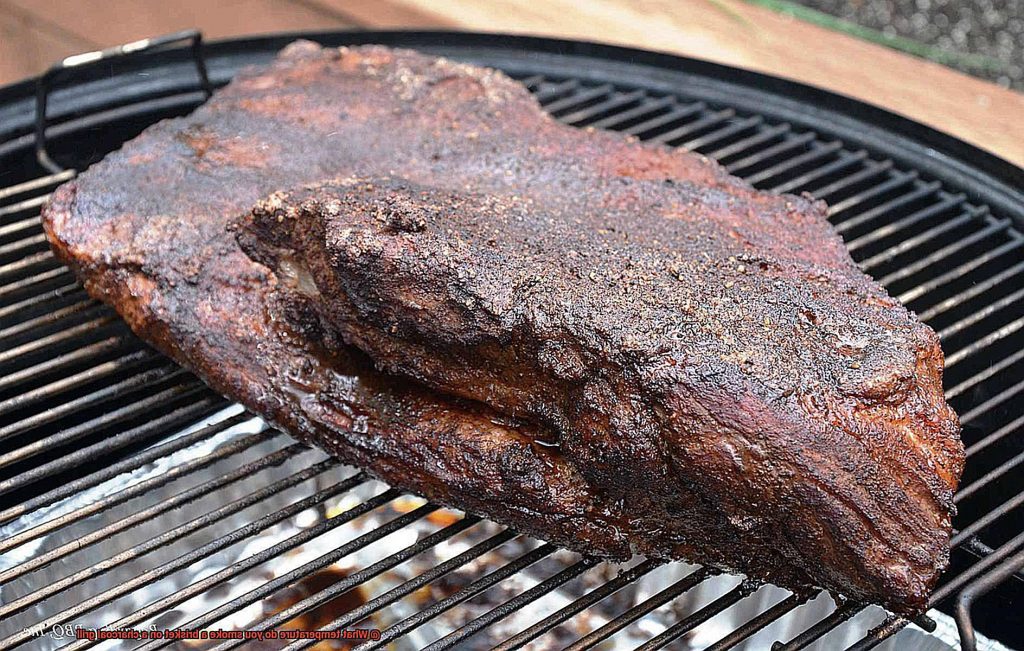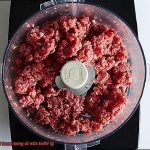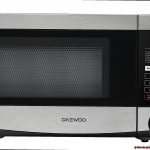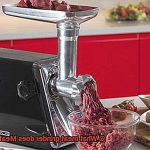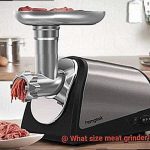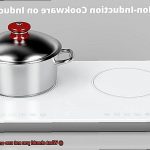Are you a grill master in search of the ultimate brisket recipe for your charcoal grill? Or are you new to the game and looking for some expert advice to get started? Well, look no further. Today, we’re tackling the question that every brisket lover needs to know: what temperature do you smoke a brisket on a charcoal grill?
When it comes to creating a succulent, melt-in-your-mouth brisket, temperature is key. But how do you find that perfect temperature on your charcoal grill? Fear not, my friend. In this post, we’ll be breaking down the optimal temperature for smoking brisket on a charcoal grill and sharing some insider tips and tricks for nailing your cook every time.
We’ll explore why starting at a low and slow temperature is crucial and how to maintain that heat throughout the entire smoking process. Plus, we’ll dive into the different types of charcoal available and how they can impact your grill’s temperature.
So strap on your apron and let’s embark on this flavorful journey into the world of smoking brisket on a charcoal grill.
Contents
The Ideal Temperature for Smoking a Brisket
Look no further than the ideal temperature for smoking a brisket on a charcoal grill. This crucial factor can make or break the tenderness, juiciness, and flavor of your meat.
So, what is this elusive ideal temperature range? It’s between 225°F and 250°F, achieved through the low and slow cooking technique that allows for the gradual breakdown of tough connective tissues. But it’s not just about hitting this range – maintaining a consistent temperature throughout the smoking process is key to producing a perfectly cooked, evenly smoked brisket. That’s where a digital thermometer comes in handy, as it allows you to monitor the internal temperature of the meat and ensure it reaches 195°F to 205°F for optimal tenderness.
But temperature control isn’t the only consideration when smoking a brisket on a charcoal grill. The type of charcoal and wood chips used can also affect both temperature and flavor. Hardwood lump charcoal is recommended for its consistent burn and natural flavor, while hickory or oak wood chips are popular choices for adding a rich smoky flavor to the meat. And let’s not forget about the importance of using indirect heat – placing the meat on one side of the grill while the charcoal is on the other side – to achieve that perfectly slow-cooked result.
Now, let’s talk time. A brisket can take anywhere from 1 to 1.5 hours per pound to smoke at the recommended temperature range. That means you need patience – lots of it. Don’t rush the process or check on your meat too frequently, as both can lead to tough and dry results.
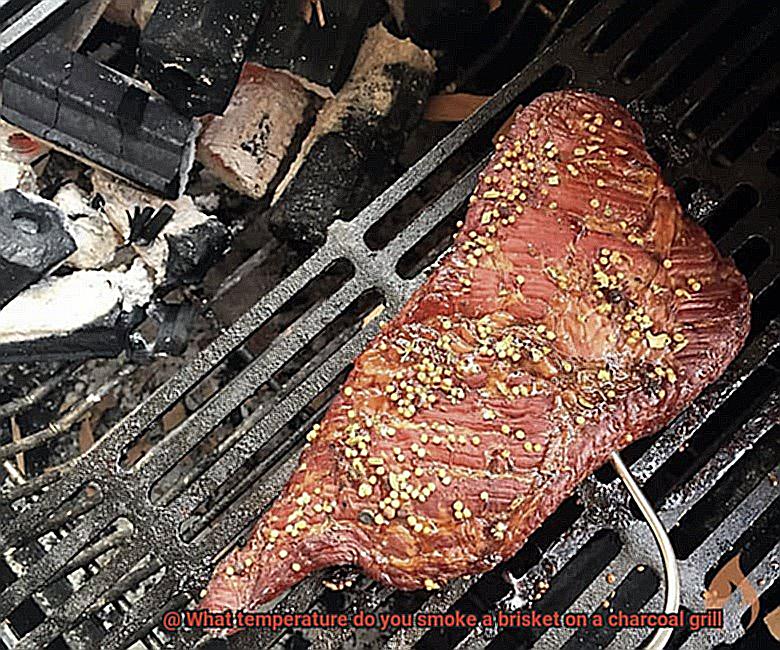
Maintaining Consistent Temperature While Smoking
Smoking a brisket on a charcoal grill is a true art form. Achieving the perfect result requires patience, skill, and attention to detail. One crucial factor in smoking a brisket is maintaining a consistent temperature throughout the cooking process. Here are some expert tips and tricks to help you master the art of maintaining consistent temperature while smoking.
Firstly, use a smoker thermometer to monitor the temperature inside the grill accurately. Place the thermometer near the brisket to get an accurate reading of the temperature. Keep in mind that the temperature near the brisket may differ from the overall temperature inside the grill, so it’s essential to check both readings. This way, you can adjust your cooking accordingly and maintain a consistent temperature.
Another technique to ensure consistent temperature is by using a two-zone fire method. This method involves creating two zones in the grill, one with direct heat and one with indirect heat. This allows for more control over the temperature and prevents the brisket from getting too hot or cold. By using this method, you can adjust the temperature as needed by moving your brisket back and forth between the two zones.
In addition to monitoring the temperature, make sure to use high-quality charcoal and wood chips for smoking. Poor quality fuel can cause fluctuations in temperature and affect the overall flavor of your brisket. So invest in quality fuel for your smoking session, and you’ll be rewarded with delicious results.
Lastly, keep an eye on weather conditions as wind and rain can affect your grill’s temperature. If it’s windy outside, try to position your grill in a sheltered area or use a windbreak to minimize disruptions caused by wind gusts. If it’s raining, cover your grill with a tarp or move it to a covered area to avoid any fluctuations in temperature.
Using Indirect Heat When Smoking
To start, light your charcoal in a chimney starter and pour them onto one side of the grill. This creates a heat barrier that allows for the smoke to circulate around the meat while placing a drip pan filled with water or another liquid on the other side regulates the temperature and keeps the meat moist.
Once your grill is set up for indirect heat, it’s time to smoke your brisket. The ideal temperature range to smoke a brisket on a charcoal grill is between 225-250°F. This low and slow cooking method breaks down the tough connective tissue in the meat, resulting in a tender and juicy brisket.
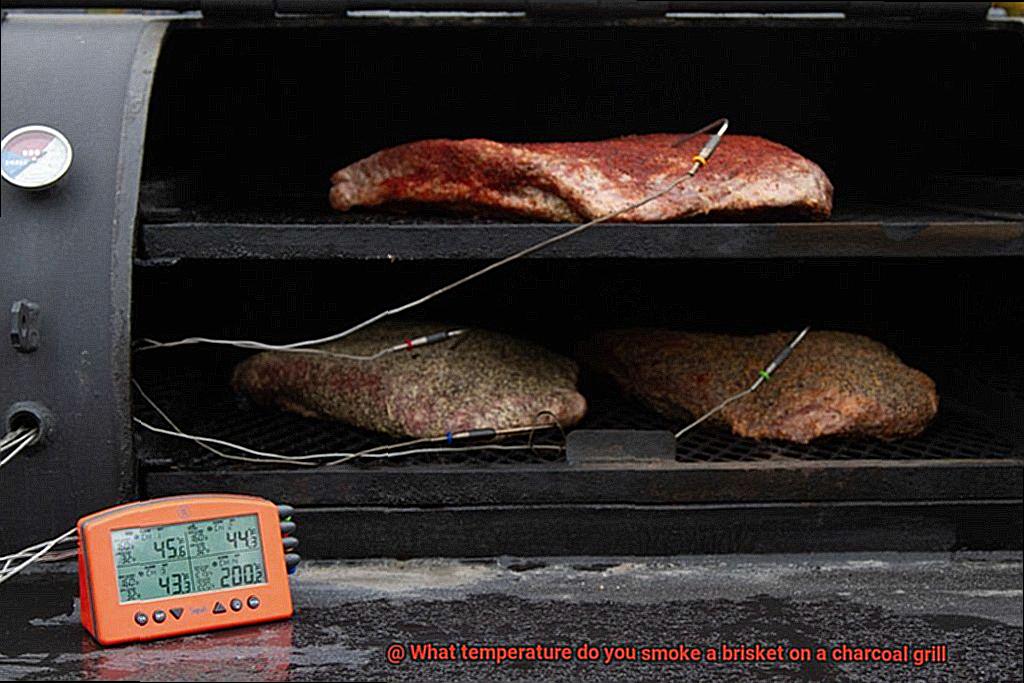
Patience is key when using indirect heat to smoke a brisket on a charcoal grill. Resist the urge to peek at your masterpiece too often as it will release valuable heat and smoke. Allow your brisket to cook low and slow until it reaches its desired internal temperature.
Monitoring the temperature throughout the smoking process is crucial. You can insert a probe thermometer into the thickest part of the brisket to ensure it reaches an internal temperature of 195-205°F, indicating that the meat is fully cooked and ready to be taken off the grill.
Adding Wood Chips or Chunks for Flavor
Before you get started, let’s dive into the key factors to consider for achieving the perfect brisket.
First and foremost, choosing the right type of wood is crucial. Different woods will impart different flavors on your meat, so it’s important to choose wisely. Popular options for smoking brisket include hickory, oak, mesquite, and applewood. Each wood brings its own unique flavor profile, so experiment to find your favorite.
Once you’ve selected your wood, the next important step is soaking your wood chips or chunks in water for at least 30 minutes. This simple step helps prevent them from catching fire and burning too quickly, which can result in a bitter taste. Instead, soaked wood chips or chunks will release a more consistent and flavorful smoke.
As you begin smoking your brisket, it’s critical to monitor the temperature of your grill. The ideal range for smoking brisket is between 225-250 degrees Fahrenheit. Too high of a temperature can dry out your meat while too low of a temperature can prolong the cooking process unnecessarily.
To ensure a consistent smoky flavor throughout the cooking process, it’s also important to periodically check on your wood chips or chunks. Adding more as needed will help maintain that delicious smoky flavor without overpowering the natural flavors of the meat.
Finally, be cautious not to over-smoke your brisket. Over-smoking can result in an overwhelming smoky taste that masks the natural flavors of the meat. Balancing the smoke with the natural flavors of the meat is key to achieving a perfectly smoky and delicious brisket.
Different Types of Woods and Their Flavors
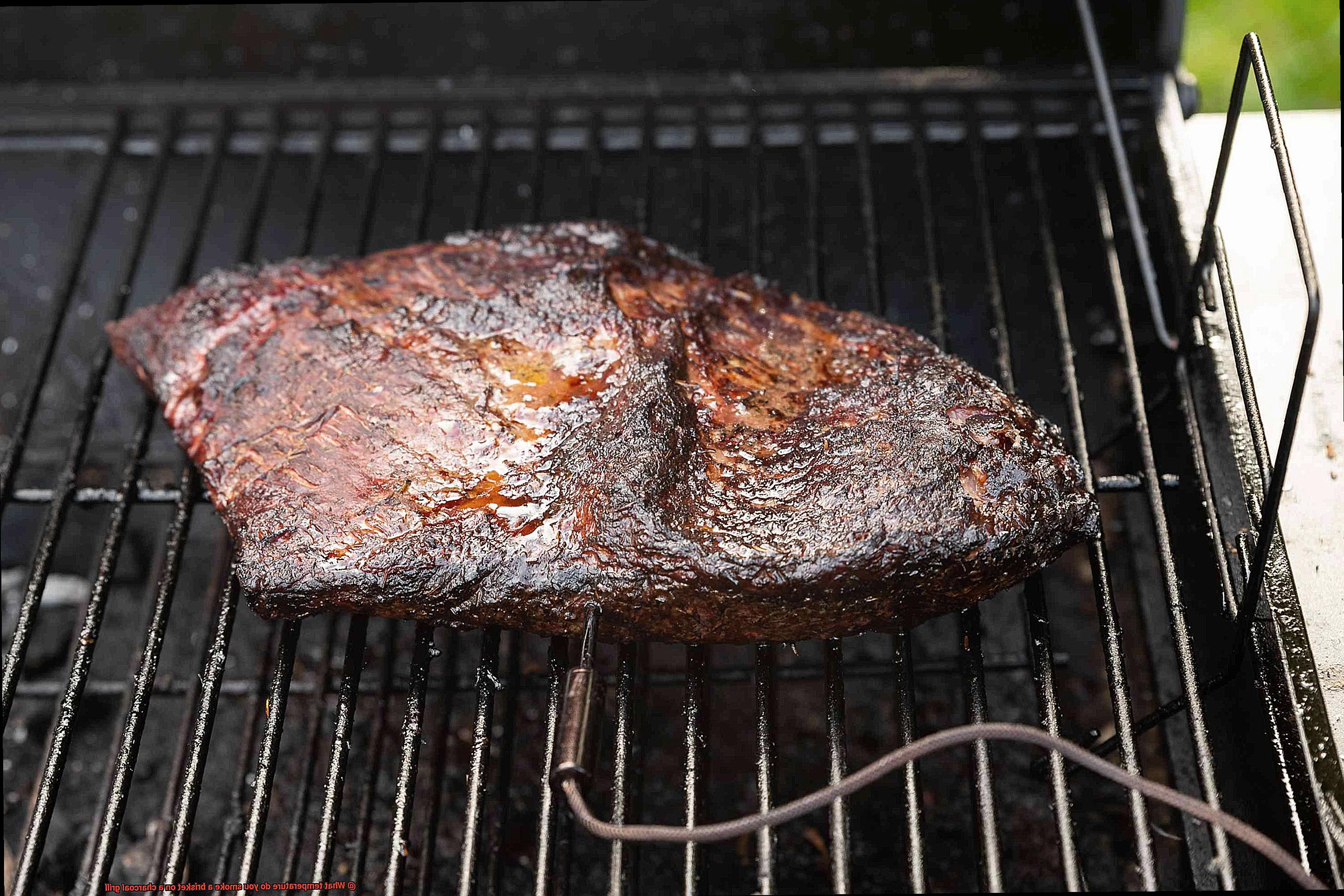
When it comes to smoking a brisket on a charcoal grill, choosing the right wood is essential in creating a mouth-watering flavor. Each type of wood has its own unique flavor profile that can either enhance or overpower the brisket’s natural taste. Here are five popular types of woods and their flavors that are commonly used for smoking a brisket:
Hickory Wood
Hickory wood is known for its bold and strong smoky flavor that pairs well with beef. If you’re aiming for a classic Southern-style barbecue flavor, hickory wood is an excellent choice.
Mesquite Wood
Mesquite wood has a distinct earthy flavor that can be overpowering if too much is used. However, when used in moderation, it can add a smoky sweetness that complements the brisket’s natural flavors.
Oak Wood
Oak wood has a milder flavor than hickory or mesquite, making it a safe choice for those who want a more subtle taste. It adds a nice smoky flavor to the meat without being too overpowering.
Apple Wood
Applewood has a fruity aroma that adds a delicate and sweet flavor to the meat. It’s an excellent choice if you want to add some subtle smokiness without overwhelming the brisket with too much smoke flavor.
Pecan Wood
Pecan wood falls somewhere between hickory and fruitwoods like apple or cherry, with a nutty and slightly sweet flavor. It complements the natural taste of the brisket and gives it a balanced smoky flavor.
It’s important to remember that finding the right balance of smoke is crucial in achieving the perfect flavor. Too much smoke can make the meat bitter or acrid, while too little smoke may not impart enough flavor. Experimenting with different types of woods and amounts of smoke is key in discovering your ideal combination.
Tips for Controlling Temperature while Smoking
Smoking a brisket on a charcoal grill is a time-honored tradition that requires precision and control over temperature. The ideal temperature range for smoking a brisket on a charcoal grill is 225-250°F. However, maintaining this temperature throughout the smoking process can be tricky. Here are five tips to help you control the temperature while smoking:
Use a thermometer
A good-quality thermometer is essential for controlling the temperature while smoking. A digital thermometer with a probe is the best option as it allows you to accurately monitor the temperature of the meat and the grill. Insert the probe into the thickest part of the brisket, away from bones and fat, for an accurate reading.
Use the right amount of charcoal
Finding the right balance of charcoal is crucial for maintaining a consistent temperature. Using too much charcoal can make it difficult to control the temperature, while using too little can cause the temperature to drop. Start with a small amount of charcoal and gradually add more as needed, until you achieve the desired temperature.
Adjust air vents
The air vents on your grill play a critical role in controlling the temperature. The more air that flows through, the hotter the grill will get. Adjusting the vents allows you to regulate airflow and maintain a consistent temperature. Open them wider to increase airflow and raise the temperature, or close them partially to decrease airflow and lower the temperature.
Use a water pan
Placing a water pan in your grill can help regulate temperature by creating a moist environment that helps to absorb heat and maintain a consistent temperature. Fill a disposable aluminum pan with water and place it on one side of your grill, away from direct heat.
Don’t lift the lid too often
Every time you lift the lid, you release heat and smoke, which can cause fluctuations in temperature. Try to avoid lifting the lid unless absolutely necessary, such as adding more wood chips or checking the temperature. When you do open the lid, work quickly to minimize heat loss.
Monitoring the Temperature with a Digital Thermometer
Then let’s talk about smoking brisket on a charcoal grill and why you absolutely need a digital thermometer to monitor the temperature. The key to perfecting your brisket is all in the details, and using a digital thermometer is one of the most important details you can’t afford to overlook.
Firstly, using a digital thermometer gives you more accurate temperature readings than relying on the built-in thermometer on your grill lid. This is crucial when it comes to maintaining a consistent cooking temperature throughout the smoking process. With a digital thermometer, you’ll be able to make adjustments to the grill’s vents or add more charcoal as needed to keep the temperature in the ideal range of 225-250°F.
But that’s not all. A digital thermometer also allows you to keep track of the internal temperature of your meat. By inserting the probe into the thickest part of the brisket without touching any bones and connecting it to your digital thermometer, you’ll be able to ensure that your brisket is cooked to perfection.
However, it’s important to note that different parts of the brisket will cook at different rates. This is where monitoring the temperature in multiple locations comes in handy. Checking various locations with your digital thermometer will help you avoid overcooking or undercooking different parts of your brisket.
So how do you get started with using a digital thermometer for your brisket? It’s simple. Just insert the probe into the thickest part of your meat and connect it to your digital thermometer. Set your desired temperature range between 225-250°F, and regularly check both the grill and brisket temperatures throughout the smoking process. If necessary, make adjustments to maintain a consistent temperature range.
Benefits of Smoking a Brisket on a Charcoal Grill
If so, smoking a brisket on a charcoal grill may be just what you need. Not only does it impart a unique and intense smoky flavor that cannot be achieved on other grills, but it also offers precise temperature control, the ability to experiment with different wood chip flavors, and affordability.
Let’s take a closer look at the benefits of smoking a brisket on a charcoal grill. First and foremost, the smoky flavor is what makes this method stand out. The combination of burning charcoal and wood chips creates a rich and earthy taste that is highly sought after by barbecue aficionados. It’s an experience that cannot be replicated by gas or electric grills.
Temperature control is crucial when cooking a brisket, and a charcoal grill allows for precise adjustments. By controlling the amount of charcoal used and adjusting the air vents, you can maintain a steady temperature between 225-250°F (107-121°C) throughout the cooking process. This ensures that your brisket is cooked evenly, retaining its moisture and tenderness.
But why stop there? Smoking on a charcoal grill also gives you the opportunity to experiment with different types of wood chips to create different flavors. Whether you prefer hickory, mesquite, oak, or applewood, the possibilities are endless. You can even mix and match to create your own unique flavor profile that will have your guests begging for the recipe.
And let’s not forget about affordability. Charcoal grills are readily available and can be purchased at a reasonable price. Additionally, charcoal and wood chips are more affordable than propane or electric smokers, making it an attractive option for those on a budget.
vBhvk9aKcBQ” >
Conclusion
In conclusion, smoking a brisket on a charcoal grill is not just a cooking method, it’s an art form that requires patience, skill, and attention to detail. The ideal temperature range for smoking brisket on a charcoal grill falls between 225°F and 250°F. Achieving this temperature range requires the low and slow cooking technique that allows for the gradual breakdown of tough connective tissues. To ensure that your brisket is perfectly cooked and evenly smoked, maintaining a consistent temperature throughout the smoking process is key.
To achieve consistency in temperature, you need to use high-quality charcoal and wood chips for smoking. It’s also important to monitor the temperature with a digital thermometer. And don’t forget about indirect heat. Placing the meat on one side of the grill while the charcoal is on the other side ensures that your brisket will be slow-cooked to perfection.
Experimenting with different types of wood chips can add unique flavors to your brisket. Popular options include hickory, mesquite, oak, applewood, and pecan wood. But finding the right balance of smoke is crucial in achieving the perfect flavor.
Smoking a brisket on a charcoal grill offers many benefits such as intense smoky flavor, precise temperature control, experimentation with different wood chip flavors, and affordability. With these tips and tricks in mind, you’ll be well on your way to creating mouth-watering brisket that will have your guests begging for more.

